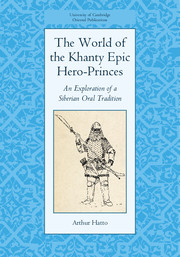Book contents
- The World of the Khanty Epic Hero-Princes
- University of Cambridge Oriental Publications 69
- The World of the Khanty Epic Hero-Princes
- Copyright page
- Dedication
- Contents
- Illustrations
- Preface and Acknowledgements
- Frontispiece
- 1 Background: The Khanty
- 2 The Eighteen Khanty Heroic Epics, Their Collectors and Publishers
- 3 Introduction
- 4 The Cosmos
- 5 Time
- 6 The Seasons
- 7 Geography
- 8 Spirits
- 9 Personae
- 10 Warfare
- 11 Armour and Weapons
- 12 Men’s Handiwork
- 13 Afterword
- Bibliography
- Index
- University of Cambridge Oriental Publications Published for the Faculty of Oriental Studies
- References
- The World of the Khanty Epic Hero-Princes
- University of Cambridge Oriental Publications 69
- The World of the Khanty Epic Hero-Princes
- Copyright page
- Dedication
- Contents
- Illustrations
- Preface and Acknowledgements
- Frontispiece
- 1 Background: The Khanty
- 2 The Eighteen Khanty Heroic Epics, Their Collectors and Publishers
- 3 Introduction
- 4 The Cosmos
- 5 Time
- 6 The Seasons
- 7 Geography
- 8 Spirits
- 9 Personae
- 10 Warfare
- 11 Armour and Weapons
- 12 Men’s Handiwork
- 13 Afterword
- Bibliography
- Index
- University of Cambridge Oriental Publications Published for the Faculty of Oriental Studies
- References
- Type
- Chapter
- Information
- The World of the Khanty Epic Hero-PrincesAn Exploration of a Siberian Oral Tradition, pp. 233 - 238Publisher: Cambridge University PressPrint publication year: 2017



